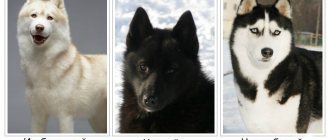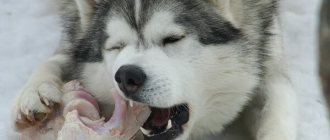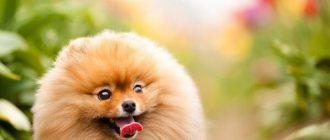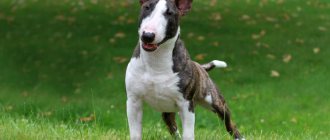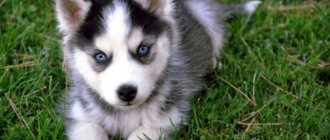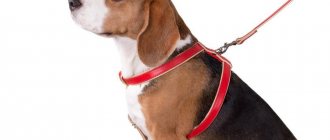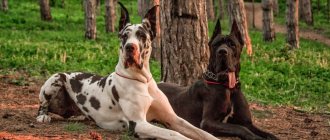Many people who like huskies, for one reason or another, cannot afford to purchase a pet of this breed.
Some people are put off by the rather large size of these dogs, while others are not satisfied with the fact that huskies are very active and need a lot of physical activity.
However, there is a way out - you can get not a standard husky, but a mini version of it.
Alaskan Klee Kais, as these dogs are called, are small in size and are much better suited for apartment living.
Description of the breed
The Alaskan Klee Kai is a small northern Spitz-type dog that resembles a standard husky in appearance. These dwarf dogs are intelligent, quick-witted and very energetic, but, unlike their larger relatives, they have never been used as sled dogs.
The Klee Kai's body is rectangular, with the withers and shoulder blades located above the loin and croup.
The head is wedge-shaped, with a slightly shortened, pointed muzzle. The eyes are preferably almond-shaped, medium set and slightly protruding. The ears are erect, triangular, with rounded tips, set quite high and close to each other.
The neck is of medium length and thickness, slightly arched. The chest is moderately deep, but not too voluminous. The back is straight and level, with a slight bend in the lumbar region.
The limbs can be quite powerful or appear light and graceful. The angles of the joints are correct, the hind legs are moderately wide.
The tail is lowered at rest, and in a state of excitement it is carried over the back and laid in a single or double ring.
The Klee Kai's coat is two-layered and very thick; it can be either quite short or long. At the same time, it is very important that in long-haired individuals the hair does not hide the outline of the body.
NOTE!
In fact, the Klee Kai is not a miniature husky. These are two completely different, although related breeds.
Description of the Alaskan Klee Kai
There are three varieties of this breed, differing in size.
The height of “toy” does not exceed 33 centimeters, weight up to 4.5 kilograms.
“Mini” have a height of 33 to 38 centimeters, weight no more than 7 kilograms.
“Standard” grows up to 43 centimeters and weighs about 10 kilograms.
Alaskan Klee Kai in photos and in life are very similar to huskies. The same elongated muzzle, a pronounced mask on it, erect ears, a curled tail.
The thick coat with dense undercoat comes in several colors. It is mainly white with black, gray or red tones. A simultaneous combination of all four colors is allowed.
History of appearance
Mini Huskies were bred in the 70s of the 20th century in the city of Wasilla, located in Alaska.
Klee Kai creator and breeder Linda S. Spurlin was interested in producing a smaller version of the standard Husky, but did not want the dogs she bred to exhibit signs of dwarfism and its attendant health problems.
In order to achieve this goal, she crossed Siberian Huskies with Alaskan Huskies, and later added the blood of American Eskimo dogs and Schipperkes to them.
From the early 1970s until 1988, Klee Kais were bred only in the kennel founded by the creator of the breed, until permission was received to breed these dogs by other breeders.
In addition, in 1995, the breed was divided into two varieties - regular Klee Kai and Alaskan. Their unification occurred in 2002, after the mini huskies were recognized by the AKC.
However, despite the fact that in America Klee Kais enjoy some popularity as companion dogs, the FCI and RKF have not yet recognized them as a separate breed. Such dogs do not have a standard and are not allowed at exhibitions except those held by organizations that recognize this breed.
Raising and training mini-huskies
If you believe the reviews of breeders, Alaskan Klee Kais are real excellent students of the dog school. They learn everything with ease and learn their lessons with pleasure. It is especially good if the teaching takes place in a playful way, and the owner does not skimp on affection and rewards the pet with something tasty. Then the mini-husky will be ready to perform any commands or even tricks.
However, like their full-sized relatives, Alaskan Klee Kais require consistent training from early puppyhood. As soon as the baby gets into a new home, he needs to patiently and persistently explain the rules and regulations. Under no circumstances should you allow a young dog to do something that you will have to wean off later. The most common mistake novice owners make is allowing their pet to sleep with them. Of course, you want to warm up and cuddle the puppy, but he will grow up pretty quickly. And an adult dog will not understand when you refuse to let him under your blanket. In addition, mini-huskies still inherited a share of stubbornness from large sled dogs. It is very difficult to discourage them from a bad habit. It's much easier to avoid problems.
The first thing a puppy must learn is its own name. Then toilet chores and the simplest commands. It is very important to train your Alaskan Klee Kai to use a collar and leash. It is not recommended to walk your dog without them. She might get lost in the city.
Like other dog breeds, Klee Kais have a difficult age. When they are a year old or a little older, a docile and obedient dog can suddenly show a rebellious character. He will try to escape, may spoil things, make tunnels, and behave arbitrarily. The owner will have to be patient and calmly stop this festival of disobedience. Harsh punishments or yelling in such a situation can only do harm. But a severe reprimand, demonstration of dissatisfaction and temporary isolation will help curb the presumptuous teenager. Alaskan Klee Kais are people-oriented dogs, so they have difficulty withstanding loneliness and neglect. Although each dog will have to find its own approach.
Alaskan Klee Kais are very sociable by nature. But for a puppy who lives in the city, additional early socialization will be useful. If he is actively introduced to other people and dogs, he will grow up to be friendly, tolerant and not display inappropriate aggression or cowardice.
Mini-huskies have adopted agility and agility from their larger relatives. These are very athletic dogs, they will enthusiastically chase and jump for a Frisbee, learn to overcome obstacles and will accompany their owner on a run or bike ride. If desired, they can master the science of agility.
Character traits
Klee Kais are friendly, sociable and playful dogs. They do not need much physical activity, but they still love to run and play with their owners. Mini Huskies are able to sense the mood of their owners well and communicate with them accordingly.
However, Klee Kais do not tolerate being alone very well and therefore are not suitable as pets for busy people.
Mini Huskies are smart, quick-witted and obedient. They readily learn new things and therefore their training is not particularly difficult. Kli-kai are distrustful of strangers and, oddly enough, despite their small stature, they make quite reliable guards who can scare away a burglar who has entered the house with their barking.
Klee Kai love children and willingly play with them, but do not tolerate rough treatment or undeserved insults.
These dogs are not characterized by aggression towards fairly large animals: mini huskies are quite friendly towards other pets and rarely conflict with them.
However, for this, the dog must be properly socialized, since Klee Kais have well-developed hunting instincts, which is why it can hunt rodents and small birds.
Expert opinion
Kozhevin Semyon Kirillovich
Expert dog handler.
“Alaskan Klee Kais have a friendly and playful personality. They are devoted to their owners and are good at sensing their mood. Klee Kais are quite silent, but sometimes, like other northern breeds, they like to howl. They are distrustful of strangers and, in general, are less sociable than huskies. At the same time, Klee Kais do an excellent job of fulfilling their purpose: with proper upbringing, they become almost ideal family pets.”
Health
Characteristic diseases
Over the four decades of the breed's existence, no genetic defects have been identified.
This means that no characteristic diseases have been noted in the Alaskan Klee Kai.
A few dog owners, and today their number officially registered by associations is just over 500, are happy to note the good health of their pets.
However, such positive results do not cancel dog vaccination.
Inseparable Klee Kai
Vaccinations
Traditional viral infections do not disturb the natural health of the breed.
If you are going to buy an Alaskan Klee Kai, you should also take care of vaccinations . The breeder must carry out the first vaccination.
Traditionally, dogs are given a comprehensive vaccination at 8-9 weeks of age, followed by a booster vaccination at 12 weeks.
Subsequent preventive measures are carried out at annual intervals.
The vaccines include drugs that counteract canine diseases such as parvovirus enteritis, leptospirosis, distemper, and rabies.
Veterinarians use complex vaccines to vaccinate animals. Nobivak, Trikat, Hexadog - all of them will protect your pet well from dangerous diseases, and decide which one to choose with your veterinarian.
The dog can hardly tolerate loneliness, so it should not be owned by those who leave home for a day to work or study
Advantages and disadvantages
pros
- Friendly.
- Loyal to their owners.
- Not prone to sabotage.
- They treat children well and play with them willingly.
- With timely socialization, they can get along with other pets.
- Well trained and obedient.
- Despite their small size, they can be good guards.
Minuses
- They cannot participate in exhibitions held by the IFF and RKF.
- They don't like to be alone.
- Sometimes they can start howling for no apparent reason.
- They love to dig the ground.
- They have great jumping ability: they can jump over a fence that is not too high.
- A rare and therefore very expensive breed of dog.
IMPORTANT!
Unlike most northern breeds, this dwarf breed does not need long walks or much physical exercise.
Character
The Alaskan Klee Kai is a playful, sociable, friendly pet. In character it is similar to the Samoyed, Karelian-Finnish husky and its direct ancestor - the husky.
He doesn’t like to be at enmity, he is ready to be friends, it would seem, with the whole world. But friendliness and devotion are shown towards the owner, family members and close people who are often in the house.
Unlike the Husky, the Klee Kai is more cautious and distrustful of strangers. This small dog has a surprisingly strong guard instinct, just like the Schipperke.
Of course, she is not able to detain an attacker with force and teeth, but she is capable of warning the owner in time about the arrival of strangers. So she makes an excellent watchdog.
It is not recommended to leave your dog and children unattended. Representatives of the breed, as a rule, cannot tolerate the screams and liberties that the child takes for a long time.
This pet enjoys playing with school-age children. But subject to a respectful attitude. Parents should teach their child how to handle a dog.
Gets along well with other pets. He can even become friends with a cat or a guinea pig. It shows a special affection for its own kind, thus manifesting the pack instinct.
Aggression among representatives of the breed is an extremely rare occurrence and only in emergency situations.
Photos of color options
of colors are currently acceptable :
- Black and white.
- Grey-white.
- Red and white.
At the same time, black-and-white and gray-white dogs should have black pigmentation of the nose, as well as the edging of the eyelids and lips. For red and white mini huskies, the pigmentation of a dark brick or brownish-liver shade is desirable.
White markings are located in places strictly defined by the standard - on the head and muzzle, as well as on the neck, chest, limbs and stomach. In this case, it is desirable to have a narrow groove on the head, a closed mask and white eyebrows.
Not long ago, AKC was recognized as the standard for mini huskies and pure white color. However, individuals with this coat color are not yet allowed for breeding, even in their homeland.
Breed standard
Although the Alaskan Klee Kai is called a smaller copy of the husky, it is an independent breed. Its representatives differ from huskies not only in size; they have larger ears and a shorter muzzle.
Klee Kai is divided into three types within the breed according to height and weight:
1. Standard Klee Kai - weight 7.3-10 kg, height 38-43 cm. 2. Miniature Klee Kai - weight 4.5-6.8 kg, height 33-38 cm. 3. Toy Klee Kai - weight no more than 4.1 kg. , height at the withers no more than 34 cm.
Disqualifying fault – height at withers more than 44.5 cm.
According to the standard, the Alaskan Klee Kai should look like this.
A wedge-shaped head rests on a strong, not too long neck. The ears are erect, triangular, and large in size. The forehead is rounded.
The eyes are medium-sized, oval-shaped, slightly convex.
The muzzle is pointed. There should be no skin folds. The bridge of the nose is relatively short. The transition from the forehead to the bridge of the nose is smooth. The nose is quite large.
The jaws are strong. The lower jaw is more developed and does not protrude forward. Cheeks and lips are dense. Scissor bite.
The Klee Kai has a rectangular body type. The top line is flat, the bottom line is slightly tucked. The back is wide and strong. Loin with a slightly noticeable curve. The chest is quite powerful for such a small dog. Protrudes forward a little.
The tail is set low. If the Klee Kai is excited, he holds it elevated or twists it into a ring. If the dog is calm, he lowers his tail to the bottom.
Legs are straight and parallel. The joints are flexible. The muscles are well developed.
According to their coat, Kli Kais are divided into long-haired and standard. Too long hair, which completely hides the contours of the body, is a serious fault.
According to the standard, the following colors are allowed: red and white, gray and white, black and white.
It is worth noting that the Klee Kai is recognized as having a pure white coat color. They can be officially registered as purebred representatives of the breed. But they have no right to take part in breeding work and in some types of competitions.
Nutritional Features
You can feed Klee Kais with both ready-made food and home-cooked food.
In the first case, the selected brand of food must correspond to the age, size, activity and physical condition of the dog. It is also very important that the food is of high quality - from premium class and above.
If the dog receives natural food, its diet should contain at least 30% protein products of animal origin. Best of all - meat or offal. In addition, it is necessary to give your pet raw or boiled vegetables, fermented milk products and rice, buckwheat or oatmeal.
NOTE!
Food for mini huskies should be fresh and prepared from good quality ingredients.
Health and life expectancy
Previously, the Klee Kai was considered a very healthy breed and virtually free of genetic diseases. But many years of research have shown that this is not entirely true.
Despite the fact that for the most part mini huskies rarely get sick, they may be predisposed to some diseases, such as:
- Thyroid diseases.
- Autoimmune tyroditis.
- Cataract.
- Dislocation of the knee joint.
- Liver diseases.
- Pyometra.
- Cardiovascular diseases.
average lifespan
Health and illness of a miniature husky replica
The first breeder of Alaskan Klee Kais, Linda Spurling, carefully monitored the health of her pets. She dreamed that dogs would grow up strong, with good immunity and not be susceptible to genetic diseases. I must admit, the breeder-enthusiast completed this task.
Mini-huskies very rarely get sick and have a fairly long life, their lifespan is 15 years or more. Although critics of this breed claim that health problems have not yet appeared, the dog population is too small and has not existed for long.
Be that as it may, for now the owners of Alaskan Klee Kais are happy with the excellent health of their charges. And dog experts advise not to forget about prevention; dogs need to be vaccinated on time, and also regularly treated for parasites. You also need to provide your pet with sufficient physical activity and not overfeed him. It’s difficult to resist giving an extra piece; miniature huskies know how to find their way to a person’s heart. They are, one might say, “professional beggars.”
Suitable for living in an apartment or outdoors?
Klee Kais are equally suitable for keeping in an apartment or in rural areas. They have quite thick and warm wool, and therefore they can easily tolerate not too severe frosts and live outside almost all year round.
In the apartment, the mini husky behaves quite decently: when left alone, it does not howl and does not spoil things.
When keeping a pet of this breed in an apartment, you will have to regularly go for walks.
Education and training
You should start raising a puppy immediately after purchasing it. In addition, Klee Kais also need socialization, without which they can be aggressive towards smaller animals.
Pet training also begins from the first days of its appearance in the house.
First, mini huskies are taught to have a nickname and keep the house clean, and later they move on to the systematic study of commands:
- "To me". This command is easy to teach your pet if you say it while showing him a treat or a favorite toy.
- "Sit". A treat is shown to the dog and raised above its head, after which this command is given. When the Klee Kai reaches for food and sits down, you need to praise him and give him a treat.
- "Lie". You need to show your pet the treat and move it forward and down so that the dog, reaching for it, lies down.
- "Ugh". If a mini husky tries to pick something up from the ground, you need to say this command and if the pet does not obey, sharply pull the leash.
- "It is forbidden". Pronounced in a stern tone, in case of disobedience, physical action follows in the form of a light slap with a rolled up newspaper or a tug of a leash on the street.
- "Near". Using a leash, the dog is pulled towards the owner's left leg, after which you need to give a command and start moving, making sure that the Klee Kai walks alongside. If the pet resists, runs ahead or lags behind, you need to repeat the command in a more stern tone and pull the dog towards you again using a leash.
IMPORTANT!
The commands “Fu” and “No” should not be confused. The first means a ban on lifting something from the ground, while the second means a requirement to stop any unwanted action.
Character and intelligence
Unlike their large prototype (stubborn and headstrong), Klee Kais are perky, sociable and cheerful. Dogs need frisky games in the fresh air (ball, frisbee, stick, etc.), long walks and constant training, from which dogs get incredible pleasure.
A mini-husky's love for its owners is boundless; the dog is not comfortable being left alone without company. It is not recommended to have Alaskan Klee Kai puppies for people who lack free time and spend the whole day at work.
Expert opinion
Anna Abramenko
An avid dog lover. Experience in veterinary medicine since 2009.
Ask a Question
Being alone, the dog will quickly get bored, which will lead to serious consequences - everything that the little husky gets his hands on will be chewed up.
Klee-kai are excellent watchdogs and are wary and wary of strangers. Dogs only accept members of their own family, so you will have to think before giving your dog away for foster care. The Klee Kai may not "make friends" with strangers.
Dogs behave appropriately towards children, do not show aggression, and are very loving. The friendliness of mini-huskies applies to everyone who lives in their neighborhood, including other pets: cats, hamsters, parrots.
With high intelligence, these dogs are easy to train. Alaskan Klee Kais remember many commands, and they like it.
Rules of care
The coat, especially if the dog has long hair, needs to be brushed daily. During shedding, this procedure must be repeated several times a day, since otherwise it will not be possible to efficiently remove the abundantly falling out undercoat.
Klee Kais are bathed infrequently, only when necessary, and it is recommended to use special shampoos intended for dogs.
The dog's eyes, ears and teeth are cleaned as needed, although they should be examined every day. The ears are cleaned with cotton swabs, the eyes with cotton pads soaked in a special composition for cleansing them.
You usually take care of your pet’s teeth yourself, cleaning them while chewing on toys or treats purchased at a pet pharmacy. If plaque has formed, which cannot be removed in this way, then the dog’s teeth are cleaned with dog toothpaste and a toothbrush.
Claws, if necessary, should be trimmed with a nail clipper, but not with nail clippers and, especially, not with scissors.
Mini Huskies are very clean, in addition, they have the habit of washing themselves with their front paws, thanks to which they themselves keep their fur clean.
Care and maintenance
Walking an Alaskan Klee Kai
Small-sized Alaskan Klee Kais are perfect for keeping both in a country house and in apartments. Proper feeding will relieve you of the characteristic “dog” smell - and this despite the long hair, which in most cases exudes an unpleasant “aroma”. The cleanliness of the dogs also adds to the karma of the breed: the Klee Kai always avoids foul-smelling garbage and does not feel the desire to roll out in it, which is what most of its relatives do.
Caring for your pet's coat will not be difficult, since these dogs spend the lion's share of their time maintaining the cleanliness of their own fur. Sometimes Alaskan Klee Kais are compared to cats for their unique ability to wash themselves with their front paws. Like felines, miniature huskies love to groom themselves: wipe their faces after a hearty breakfast or wash off dust after an overly active walk. Klee Kais do not need frequent water treatments - it is enough to bathe the dogs two to three times a year using a special pet shampoo.
To comb out wool, it is recommended to purchase mittens with silicone growths or a stiff brush. The procedure is carried out once a week. Of course, during molting, which occurs twice a year (in spring and autumn), you will have to do this every other day or even more often. This will help avoid the formation of tangles from the outgoing down. Contrary to popular belief, Alaskan Klee Kais do not require regular trimming. Nature has rewarded these dogs with the ability to do as much as possible without human intervention. However, this does not give you the right to give up caring for your pet.
In general, Klee Kais are not susceptible to colds, so it is better to reserve winter clothes for other breeds. These dogs happily “swim” in the snow and will lick the first icicle they can reach. But it is better to avoid drafts, especially after water treatments, since the poor immunity of individual animals has not yet been abolished.
Klee Kai on a bench
Many novice dog breeders pay attention to their pets' ears last, and in the case of Alaskan Klee Kais, this is a mistake. Representatives of the breed love to rummage in the ground, so after a walk, take the trouble to examine the animal’s ears. Dirt can get there, and this will cause the development of an inflammatory process. Wipe your pet's ears with a finger wrapped in damp gauze. Do not use cotton swabs under any circumstances: one careless movement and you will damage your dog’s eardrums.
Check your Alaskan Klee Kai's eyes regularly for debris. To remove them, use a damp, lint-free cloth or cotton pad. A decoction of chamomile or chilled strong tea is suitable as an aid.
Don't forget about your pet's mouth. Soft foods can contribute to tartar formation and gum problems. Use special sticks for cleaning teeth, which, in addition to their main purpose, will also serve as a good treat for the dog. In particularly advanced cases, a special paste that can be purchased at a pet store will help.
Klee Kai's claws should be trimmed as needed using a special nail clipper. On average, you will have to resort to this procedure once or twice a month. Don't forget to use a nail file to smooth out any jagged edges.
Hard paw pads are prone to cracking if not properly cared for, so be sure to regularly lubricate them with a rich cream. If wounds form, use an antiseptic to prevent inflammation.
Alaskan Klee Kais can be called omnivores and are absolutely picky in their diet. Choose for yourself: a balanced menu of natural products or appropriate high-quality dry food. Combining both options is extremely undesirable - this provokes digestive problems in some dogs.
Eliminate the following from your Alaskan Klee Kai's diet:
- raw eggs and uncooked meat;
- dairy products (does not apply to puppies);
- spicy, fatty and salty foods;
- lamb and pork;
- legumes;
- yeast dough;
- tubular bones;
- river fish;
- raw mushrooms;
- sweets.
Please note: babies have accelerated metabolism, so be prepared for unpleasant “surprises”. Try to take your babies for a walk once an hour, after eating and sleeping. This will reduce the likelihood of unscheduled cleaning.
There should always be drinking water in your pet's bowl. It is recommended to use bottled. You can also give tap water, after steeping it for 6-8 hours.
Alaskan Klee Kais require constant physical activity, and this should not just be jogging in the yard without a leash, because the same schedule makes the dog bored. Try to get out into nature with your pet more often: here you can learn a new command, repeat old ones, and simply enjoy leisure time together.
How to choose the right puppy?
You need to purchase Klee Kai only from a nursery. Moreover, since the breed is rare, you may have to wait quite a long time until the puppies that have not yet been reserved are born.
When choosing a baby, you need to pay attention not only to his appearance, but also to his character, temperament and state of health. The puppy must be active and playful, showing a friendly curiosity towards people and willingly communicating with other dogs in the kennel.
It is undesirable to adopt a puppy that shows aggression or cowardice - he will almost certainly have mental problems, which will subsequently greatly complicate his socialization and training.
NOTE!
Despite the fact that many nurseries provide such a service as delivery of the puppy to the buyer, it is better to go for the future pet yourself.
After all, it is not always possible to understand from a photograph how good a puppy’s exterior is. In addition, when buying a mini husky in this way, it will be impossible to check his psyche and temperament.
Price
In Russia the breed is not widespread and little known. The price of an Alaskan Klee Kai reaches 350,000 rubles.
Crossbreeds with minor breed defects or without a pedigree are several times cheaper.
While miniature huskies are exotic for Russia, they are found only at exhibitions. But given their grace and charm, the situation may well change.
Cairn Terrier - description of the breed, standards, character and price of the dog. 125 photos and video descriptions of Cairn TerriersBichon Frize - description of the characteristics of the breed, cost per puppy, standards and characteristics of the dog (110 photos)
- Italian Greyhound - features of the breed, descriptions of purebred dogs and tips for choosing puppies (video and 100 photos)
